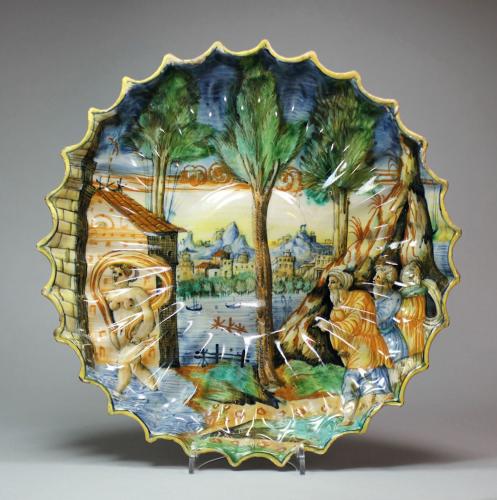
Price on application
This object is eligible for a Certificate of BADA Provenance
The BADA Standard
- Since 1918, BADA has been the leading association for the antiques and fine art trade
- Members are elected for their knowledge, integrity and quality of stock
- Our clients are protected by BADA’s code of conduct
- Our dealers’ membership is reviewed and renewed annually
- Bada.org is a non-profit site: clients deal directly with members and they pay no hidden fees
Dutch Delft wet drug jar, mid 18th century, in tin-glazed earthenware, of globular form with short spout and collared rim, supported on a tall spreading foot, decorated to the front in blue with an elaborate crenellated cartouche with a winged cherub’s head between floral swags, surmounted by a basket of fruit and two peacocks, inscribed S CIRCHOR;C;RHE.
Height: 20.5cm. (8 1/16in.)
Notes:
This jar was intended to hold syrup of chicory (cichorium), which has been prized for its nutritional and medicinal properties for thousands of years. The earliest culinary record of the plant is in a first century Roman recipe book called ‘apicius de re coquinera’; in Ancient Rome ‘puntarelle’, or chicory sprouts, were generally eaten dressed with garum, a fermented fish sauce. In 17th century Europe it also became popular as a supplement to coffee, which had only recently begun to be imported from the New World. As a medicine, it was used in Ancient Rome, Greece and Egypt as an aid to digestion; extant records of its preparation and use include those written by Theophrastus, a pupil of Aristotle, and Pliny the Elder, who used chicory concoctions to treat both digestive and visual disorders. The root’s anti inflammatory properties made it an extremely popular pharmaceutical ingredient to treat various ailments, and the medicinal applications of chicory continued to expand throughout the Middle Ages. During the Renaissance all parts of the plant were used; roots, leaves, stems, flowers, seeds and milky juice; whereas in earlier centuries popular methods of consumption included drinking the juice from the crushed leaves (specifically advised for liver and spleen complaints) or drinking a concoction of fermented honey, salt and a dried powdered form of the plant, in the 16th and 17th centuries a more popular preparation method was cooking the juice and leaves to a syrup, which would then be stored and sold in a wet drug jar such as this. In more recent times, the plant was discovered to contain inulin, a dietary fibre with prebiotic properties that can help to control diabetes and generally improve digestive health.
Dimensions
Height: 20.5cm. (8 1/16in.)Stock number
W803The BADA Standard
- Since 1918, BADA has been the leading association for the antiques and fine art trade
- Members are elected for their knowledge, integrity and quality of stock
- Our clients are protected by BADA’s code of conduct
- Our dealers’ membership is reviewed and renewed annually
- Bada.org is a non-profit site: clients deal directly with members and they pay no hidden fees


